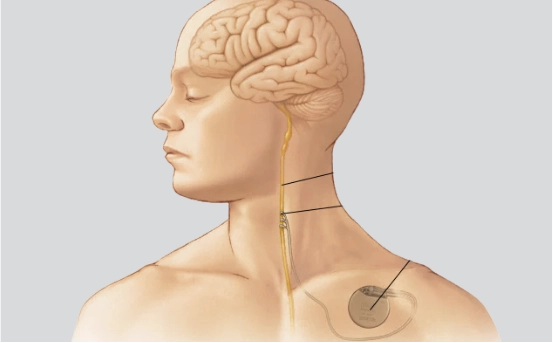Vagus nerve stimulation (VNS) has gained attention for its role in treating various neurological and psychological disorders. Whether you’re researching alternative treatments for epilepsy or seeking innovative methods to manage depression, VNS therapy may have caught your attention. But what exactly is vagus nerve stimulation, and how does it work?
The vagus nerve often called the “wandering nerve” due to its long and winding path from the brainstem to the abdomen acts like a communication superhighway, transmitting signals between the brain and various organs. For this reason, stimulating it can produce wide ranging effects, from regulating heart rate and digestion to influencing mood and seizure activity. Medical researchers and practitioners have tapped into this powerful pathway through VNS, aiming to reset or balance the nervous system’s functioning.
What is Vagus Nerve Stimulation?
Vagus Nerve Stimulation (VNS) is a medical treatment that involves sending mild electrical pulses to the vagus nerve using a device similar to a pacemaker. These electrical impulses help modulate activity in certain brain areas, often leading to symptom relief for conditions like epilepsy and treatment-resistant depression.
The stimulation is typically delivered by a small implantable device, usually placed under the skin of the chest, with a wire connected to the vagus nerve in the neck. The device is programmed to deliver electrical impulses at specific intervals, which can be adjusted by a healthcare provider depending on the patient’s response to the therapy.
Because of its vast connections, the vagus nerve is a key communication channel between the brain and various internal organs. Stimulating this nerve can influence many physiological responses, which is the foundational idea behind VNS therapy.
How Does Vagus Nerve Stimulation Work?
Although the exact mechanisms are still being researched, VNS is believed to alter how brain circuits function by modifying neurotransmitter levels such as serotonin, norepinephrine, and gamma-aminobutyric acid (GABA). These changes can help stabilize mood and reduce seizure frequency.
The electrical signals sent via the vagus nerve influence various parts of the brain involved in emotion, alertness, and seizure activity. Over time, consistent stimulation may normalize irregular brain activity, offering relief from chronic symptoms of certain neurological and psychiatric disorders.
Medical Conditions Treated with VNS
Vagus nerve stimulation is FDA approved for specific health conditions and is being studied for many others. Below are the most common uses :-
- Epilepsy :- VNS is widely used for people with drug resistant epilepsy, especially when surgery is not a viable option. For many patients, VNS helps reduce the frequency and intensity of seizures, improving their quality of life. It is not a cure but serves as an effective adjunct therapy when medications alone are insufficient.
- Depression :- In 2005, VNS was approved in the U.S. as a treatment for chronic or treatment-resistant depression, particularly for patients who do not respond to multiple antidepressant medications. Studies have shown that VNS may gradually lead to improved mood and overall mental well being.
- Investigational and Off label Uses :- Researchers are exploring VNS for a wide range of other conditions, including anxiety disorders, Alzheimer’s disease, chronic pain, migraines, obesity, tinnitus, and inflammatory disorders like Crohn’s disease and rheumatoid arthritis. While more evidence is needed, preliminary results are promising, pointing to the vagus nerve’s role in regulating inflammation and emotional responses.
The VNS Procedure: What to Expect?
The process of getting a VNS device is typically done through a minor surgical procedure that takes about 1-2 hours. The device is implanted under the skin in the upper chest, and a thin wire called a lead is tunneled under the skin to connect to the left vagus nerve in the neck.
This procedure is usually performed under general anesthesia, and most patients can go home the same day or the next. After recovery, the device is activated and programmed using a handheld wand by a neurologist or specialized clinician. Settings may be adjusted over time to maximize benefit and minimize side effects.
Patients are also provided with a magnet that allows them to manually activate the device if they feel a seizure coming or experience sudden mood changes.
Benefits of Vagus Nerve Stimulation
For eligible patients, VNS therapy offers several benefits :-
-
Reduced seizure frequency :- Especially in epilepsy patients who haven’t responded to medications.
-
Improved mood stability :- Notably in people with treatment-resistant depression.
-
Minimal daily maintenance :- Once implanted and programmed, the device works automatically.
-
Non pharmaceutical approach :- VNS provides an alternative or complement to medication.
Many patients report an overall improvement in quality of life, with fewer hospitalizations and better day to day functioning.
Potential Side Effects and Risks
As with any medical intervention, VNS comes with potential side effects, though they are generally mild and manageable. Common side effects include :-
-
Hoarseness or changes in voice
-
Coughing or throat discomfort
-
Shortness of breath during stimulation
-
Tingling in the neck
-
Sleep disturbances in some cases
These symptoms typically occur during active stimulation periods and often lessen over time. Serious complications from the surgery itself are rare but can include infection, nerve damage, or device malfunction.
Who is a Candidate for VNS Therapy?
Not everyone is an ideal candidate for vagus nerve stimulation. Typically, VNS is recommended for :-
-
People with drug resistant epilepsy (after trying at least two medications)
-
Patients with chronic, treatment resistant depression
-
Those who are not suitable for brain surgery
-
Patients seeking non drug alternatives for long term symptom control
A comprehensive evaluation by a neurologist or psychiatrist, including medical history, current treatments, and individual symptoms, is necessary to determine eligibility.
Living with a VNS Device
After the VNS device is implanted and optimized, most patients return to their normal daily activities, including exercise and travel. Routine follow up appointments are required to adjust stimulation settings and ensure the device is functioning correctly.
The battery of the implanted device typically lasts 5 to 10 years, after which a minor surgical replacement may be needed. Many patients adapt well to the device and report feeling empowered by the additional control it offers over their health.
Conclusion
Vagus nerve stimulation is a promising treatment option for individuals suffering from chronic epilepsy and depression, especially when other treatments have failed. With its minimally invasive nature, long term benefits, and expanding list of potential applications, VNS continues to be a valuable tool in modern neurology and psychiatry.























